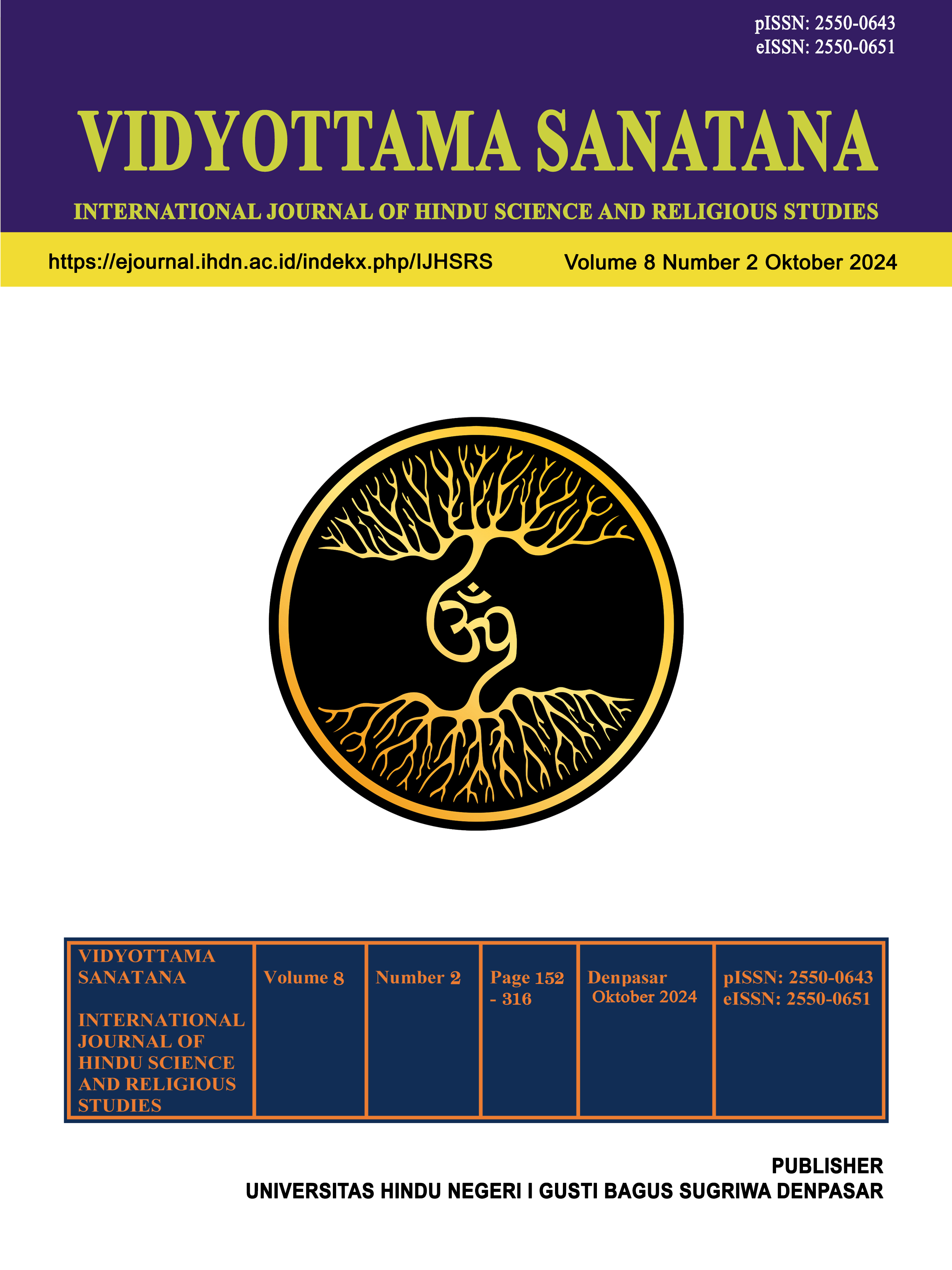CULTIVATION OF RELIGIOUS CHARACTER EDUCATION AT THE MEPEPADA CEREMONY AT PURA AGUNG KERTAJAYA TANGGERANG
DOI:
https://doi.org/10.25078/vidyottama.v8i2.3306Abstrak
Upacara yajna merupakan dasar ajaran agama Hindu, termasuk tattva dan etika. Umat Hindu melaksanakan ajaran agama melalui upacara yajna. Ada lima yadnya yang selalu dilaksanakan, yaitu Dewa Yadnya, Bhuta Yadnya, Manusa Yadnya, Pitra Yadnya dan Rsi Yadnya. Menariknya, setiap pelaksanaan upacara Mupuk pedagingan selalu diiringi dengan upacara mepepada, seperti pada upacara Numpuk pedagingan di Pura Agung Kertajaya Tanggerang. Upacara mepepada ini menarik untuk diteliti khususnya dalam penanaman nilai-nilai pendidikan karakter.
Metode penelitian yang digunakan adalah kualitatif, pengumpulan data melalui wawancara dan observasi. Hasil penelitian menunjukkan adanya penanaman pendidikan karakter religius pada upacara mepepada: kepercayaan terhadap Dewa Siwa dalam wujud Rare Anggon turun ke dunia menjemput atman hewan yang dijadikan yadnya, percaya adanya kesamaan atman baik hewan maupun manusia, percaya karma baik hewan yang dijadikan yadnya akan mendapat penyucian dan percaya punarbhawa yaitu evolusi hewan yang dijadikan kurban suci akan terlahir menjadi makhluk yang lebih baik atau berguna dari sebelumnya.
Referensi
Althof, W., & Berkowitz, M. W. (2013). Character and Civic Education as a Source of Moral Motivation. In: Handbook of Moral Motivation. Moral Development and Citizenship Education. In Handbook of Moral Motivation. Moral Development and Citizenship Education (Vo. 1, pp. 567–584). SensePublishers. https://doi.org/https://doi.org/10.1007/978-94-6209-275-4_31
Asmarani, N. N. O. (2020). Kurban Hewan Dalam Upacara Yadnya: Membunuh Atau Memuliakan? Jurnal Filsafat, 30(1), 46–71. https://doi.org/10.22146/jf.41794
Bhalla, P. P. (2015). Tata Cara, Ritual Dan Tradisi Hindu (I. K. Donder (ed.)). Paramita.
Berkowitz, M. W., & Bier, M. C. (2004). Research-Based Character Education. The ANNALS of The American Academy of Political and Social Science, 591(1), 72–85. https://doi.org/https://doi.org/10.1177/0002716203260082
Durkheim, E. (2011). The Elementary Forms Of The Religious Life (E. A. . Iyubenu & A. Fahrudin (eds.); Baru). IRCiSoD.
Easwaran, E. (2008). The Upanishads (Second). Nilgiri Press.
Griffith, R. T. . (2009). Yajurveda Samhita (Dewanto (ed.); kedua). Paramita. http://www.paramitapublisher.com
Kajeng, I. N. dkk. (2003). Sarasamuccaya (pertama). Paramita. http://www.paramitapublisher.com
Maswinara, I. W. (2022). Wedanta. Sudianieducation.Com. https://www.sudianieducation.com/2022/02/27/bab-i-wedanta/
Mishra, P. ., Paramita, I. G. A. D., & Pandewi, D. S. (2008). Hindu Dharma: The Universal Way Of Life Tejemahan (I. K. Donder (ed.); Pertama). Paramita. http://www.paramitapublisher.com
Radhakrishnan, S., & Mantik, A. S. (2008). The Principal Upanisads (Pertama). Paramita. http://www.paramitapublisher.com
Saraswati, I. A. G. A., & Paramita, I. G. A. (2016). Konsep Surga, Neraka Dan Moksa Dalam Kakawin Candra Bairawa. Jurnal Dharmasmrti, XV(28), 1–138.
Sethumadhavan, T. N. (2011). Svetasvatara Upanisad. Shri Ganesh Chaturth.
Sivananda, S. (2003). Intisari Ajaran Hindu. Paramita.
Sivananda, S. S. (1999). Amrita Gita (WWW). The Divine Life Society.
Sivananda, S. S. (2005). Pikiran Misteri dan Penaklukannya (1st ed.). Paramita.
Sudiani, N. N. et al. (2021). Nilai-nilai Pendidikan Karakter Religius pada Geguritan Pan Balang Tamak. 1–16.
Sudiani, N. N. (2020). Pencegahan Wabah Covid-19 melalui Pendidikan Karakter Peduli Lingkungan pada Anak Usia Dini. In K. A. P. Dewi & J. Simarmata (Eds.), Book Chapter Covid-19: Perspektif Pendidikan (1st ed., p. 17). Yayasan Kita Menulis.
Sudiani, N. N. (2023). Modul Brahmavidya. Sudianieducation.Com. https://www.sudianieducation.com/2023/09/28/modul-brahmavidya/
Sudiani, N. N., Hemamalini, K., & Angga Irawan, I. ketut. (2021). Nilai-Nilai Pendidikan Karakter Religious Pada Geguritan Pan Balang Tamak. Cetta: Jurnal Ilmu Pendidikan, 4(2), 15. https://jayapanguspress.penerbit.org/index.php/cetta/article/view/1313/705
Sudiani, N. N., Hemamalini, K., & Saklit, I. W. (2022). Metode Pendidikan Bhagawan Domya Sebagai Upaya Membentuk Siswa Berkarakter. Kamaya: Jurnal Ilmu Agama, 5(2), 87–103.
Sudiarga, I. M., Subandia, I. made, Karyawan, I. K., & Asmarini, N. P. (2000). Nilai Budaya Dalam Geguritan Sudhamala. Departemen Pendidikan Nasional.
Taniputera, I. (2005). Atharvaveda Samhita II (Pertama). Paramita. http://www.paramitapublisher.com
Tim pengkaji dan Penerjemah. (2021). Bhagavadgita dan Terjemahannya (1st ed.). Direktorat Jenderal Bimbingan Masyarakat Hindu Kementerian Agama RI.
Wartayasa, I. K. (2018). Pelaksanaan Upacara Yadnya Sebagai Implementasi Peningkatan Dan Pengamalan Nilai Ajaran Agama Hindu. Kamaya: Jurnal Ilmu Agama, 1(3).
Wijaya, P. S. (2015). Siva Purana Vol.III. Paramita.
Wood, A. (2000). Interpreting the Upanishads.
Yunairi, D., Donder, I. K., & Widiana, I. G. P. G. (2019). Filsafat Manusia Dalam Teks Tutur Raré Angon. Jurnal Penelitian Agama Hindu, 3(1), 44–56.













